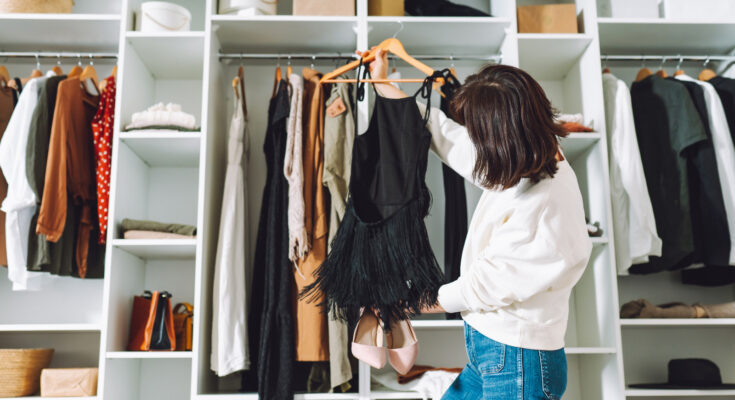Clothing Items To Get Rid Of For A More Organized And Clutter-Free Closet
Clothing, shoes, and accessories play a large role in everyone’s life, no matter how fashion-savvy or fashion-inept they may be. Even if a person works remotely, rarely goes out, and prefers a homebound lifestyle, they need space to store essentials, like everyday outfits, underwear, and shoes. Closet space and clothing storage aren’t infinite and can easily become a place of cluttered chaos over years of lifestyle changes and events.
Without routine clean-outs, anyone can garner a large collection of clothing items. Free t-shirts from events, old shoes, a jacket saved from teenage years, and other miscellaneous memories can clutter a closet, taking up valuable storage space and making organization a struggle. Cutting out unneeded items makes getting ready every day easier. There are fewer unworn outfits to sift through, and it’s much more calming to look into a closet and know that every clothing piece fits and has the potential to be worn.
Below are eight expert tips on clothing items to get rid of for a more organized and clutter-free closet. It’s inevitable to gather unwanted clothes, shoes, and accessories over time, but there’s no reason to hold onto them if they don’t contribute to your current routine. Tracy McCubbin, professional organizer and CEO of dClutterfly, tells House Digest exclusively, “Don’t beat yourself up about things you’ve bought and never worn or let that stop you from letting it go. Don’t hang on to something you don’t like or won’t wear just to justify the money spent.” With this advice in mind, read on for more suggestions on how to downsize your closet and boost your organization.
Duplicate basics take up space and often go unworn
Whether fashion takes precedence in your life or is simply a means of clothing yourself, it’s recommended to have several variations of clothing staples. Every day t-shirts, jeans, and shorts are great to have on hand and are easily dressed up with nice shoes or accessories. However, there is such a thing as too many clothing duplicates. That 10-pack of white t-shirts at Walmart may seem like a good deal, but does anyone really need that many? Especially if you’re doing laundry regularly.
Organization Expert and Founder of Organize Every Room, Cara Palmer, recommends exclusively to House Digest, “Keeping no more than two to three white t-shirts, black pants, or similar staples. Assess the condition of each and keep only those that fit perfectly and look their best.” The beauty of basic tees, shorts, and pants is that they’re available at retailers in brick-and-mortar locations and online throughout the year. There’s no reason to stock up on these clothing items when they’re always available for purchase. Palmer also adds, “If you can’t see it, you won’t wear it.” You may be able to stuff four pairs of black pants in a drawer, but you’ll likely just reach for the ones closest to the front. As you wash them and replace them at the front of the drawer or hanging rod, the others are lost and unworn in the depths of a closet. Consider finding foolproof ways to organize deep shelves in your closet, and hold off on stocking up on duplicates until you actually need them.
Someday sizes are bad for your mental health and closet organization
Bodies are bound to change size and shape throughout a person’s life. It can be hard to let go of items that used to fit, but there’s no reason to hold onto unusable items. Even if unworn and preserved at the back of your closet, clothes still age and lose quality over time. McCubbin reveals, “A comprehensive decluttering requires pulling everything out and trying it on, and this takes time.” Trying on all of your clothes might be an hours-long process, but it’s the only way to guarantee what fits and what doesn’t. McCubbin recommends, “You will want lots of light, a mirror, and to wear good foundation pieces to try clothes on.” Don’t keep every little thing that fits right; consider if you actually like the way it looks. If it isn’t flattering, has an uncomfortable seam, contains itchy fabric, or has any other feature that makes you question if you’ll ever wear it, put it aside.
In respect to your mental health, Palmer says, “Clothes that no longer fit but are kept ‘in case’ take up valuable space and can affect your self-image. Consider donating these items if your size hasn’t changed for over a year.” It’s all about honoring — and tailoring your closet — to who you are at the present time. If your size changes, you can purchase new clothes then, but it’s important to feel comfortable and confident in the now. Plus, eliminating the items that do not fit frees up valuable space for those that do, and for whatever you wish to purchase in the future. Clothes in decent condition can be handed down to family or friends, or you can donate them. If your ill-fitting stack has holes discoloration, or is too old to ethically pass on to someone else, repurpose the old clothing in your home and garden.
Short-term fads may no longer interest you
In an age of inflation and rapidly changing trends, fast fashion has enabled many short-term fashion fads. This has left closets full of outdated clothing, shoes, and accessories. Palmer states these items “create visual noise in your closet.” They likely aren’t coming back in style any time soon and will simply take up space and block your view of items more befitting your current taste.
To help determine what should stay and what should go, there are some useful rules of thumb to follow. Palmer says, “If you haven’t worn something from a past trend in the last year, you will likely not revisit it. Keep only the timeless pieces that consistently make you feel confident.” McCubbin says to ask yourself three questions to decide whether to keep fad-related clothing items: “If you saw it in a store today, would you buy it again? Do you feel beautiful/cute/handsome/comfortable in it? Have you ever worn it out of the house?” If you answer “no” to any of these, then it’s probably time for the item to get the boot and free up more of that valuable space. Donate, give away, or sell your puffy faux fur coats and cottagecore-style dresses. Consider listing items you’ve barely worn on popular secondhand clothing sites, like Depop, Mercari, and Poshmark. Someone else will treasure the clothing piece, and you’ll get a small return in the form of money — not to mention a more clutter-free closet.
You don’t need an excess of special occasion outfits that were only worn once
Many people have formal or niche clothing items for specific events or outings. Palmer says, “Unless you attend formal events regularly, limit yourself to one to two versatile formal options and consider renting for truly special occasions.” If you have an image to uphold and don’t want to be seen in the same outfit on multiple occasions, “Consider renting for truly special occasions.” This is a better approach for your closet space, your budget, and for the environment. Renting formal wear reduces fashion waste, which is a growing problem. TheRoundup.org reports that there are around 92,000 tons of textile garbage every year!
Go through your closet and part ways with special occasion outfits you won’t be wearing again. Donate them, hand them down to other family members, or sell them online. Given that these clothing articles aren’t everyday clothes, it’s highly likely that they don’t have any damage or discoloration. With “like new” condition, they may be worth trying to sell. Depop and eBay are two of the best places to sell, since they only charge a 10% and 12.35% cut of your sales, respectively. If your special occasion clothing is a designer brand, sites like The RealReal solely sell more high-end pieces, making it easier to find a buyer for these higher ticket items. Just remember that taking photos, uploading them, adding information, and keeping up with listed items can be time-consuming. McCubbin says, “You are going to get pennies on the dollar of what you spend on the item,” so if you don’t have the time to make listings, dropping them off at secondhand shops or donating may be a more sensible choice. Whatever route you decide to take, the important takeaway is to free up closet space by eliminating an excess of special occasion outfits.
Either fix or toss clothing with damaged buttons, zippers, or holes
Even the most expensive clothes aren’t built to last forever. Over months or years of extensive wear, lost buttons, misaligned zippers, torn pockets, and stained fabric are inevitable. Take a look at the damaged items in your closet and consider how long they’ve been in their current state. Palmer encourages you to get rid of clothing “that has remained unworn and unfixed for months should be discarded.” She continues, “Be honest about whether you’ll repair these items or if they’re taking up space.”
It’s time to make an executive decision. Fill a box with clothes that need repairs and add it to your to-do list for the week, or get rid of them. If damage is irreparable, there’s no reason to keep it sitting around. Of course, this isn’t always the case. Some clothing repairs are easy and can be DIY’d with minimal sewing knowledge. Hopefully, you haven’t washed these items yet, since torn clothing should be repaired before putting them in the laundry. Replacing buttons and strengthening seams requires only a needle, thread, and precise handiwork. There’s even a chance you may know someone willing to give you a hand in this regard. Either way, there is just no point having your closet cluttered with damaged items. You have two choices: Repair them or get rid of them.
Consider clearing out sentimental clothing items that are unlikely to be worn again
Throughout life, people are bound to gather sentimental clothing pieces that they don’t want to part with. These items usually have important memories attached, and you shouldn’t necessarily clear them all out if they mean the world to you. Palmer says, “While some sentimental items deserve space, a collection of concert t-shirts or college sweatshirts can overwhelm your closet.” Many of these items may fall under other reasons to downsize, such as no longer fitting you or not suiting your current sense of style.
Palmer recommends choosing just one or two truly meaningful pieces from these collections to hold on to. This can significantly downsize your closet and reduce clutter without tossing away all of your memories. If you have a knack for crafting, consider repurposing pieces into a quilt, pillowcase, or shadowbox. There are also other clever ways to use old t-shirts around your home and garden, making your nostalgic clothing items as useful as they are reminiscent.
Get rid of clothing pieces that no longer fit your lifestyle
People change and so do their lifestyles. Whether you move to a new climate, begin a different career path, or change up other parts of your lifestyle, your usual outfits may slowly fade to obscurity. This isn’t a bad thing, and it happens often. Palmer again has advice for this situation, “That collection of business suits may no longer serve you if you work remotely. Keep clothing that supports your actual daily activities rather than imagined scenarios.” Think about where you are now — there’s no reason to hold onto a dozen bulky jackets or pantsuits if you push past them more often than you use them.
Be honest with yourself: Do you have concrete plans to start a gym routine, return to in-office work, or move back to a place with colder weather? If yes, then don’t part with these items. Store them someplace out of the way, following an expert’s advice for storing off-season clothes. On the other hand, when life is clearly taking a new trajectory, part ways with your past garments. You don’t have to clear out every last piece of clothing; simply downsize so you only have one or two of these niche outfits, so they don’t take up as much storage space. It doesn’t hurt to hold onto at least one business suit or bathing suit coverup in case you need them again at some point.
Uncomfortable shoes are detrimental to your closet space and body
While social media can provide pertinent life advice, don’t listen to the influencers who put beauty before comfort and health. There’s no reason to keep uncomfortable shoes, no matter how wonderfully they tie together an outfit. There are thousands of shoes on the market, and there’s guaranteed to be another gorgeous pair out there that fits your style without destroying your feet. Palmer says, “Shoes that cause blisters or pain or that you can’t walk more than a block in take up valuable real estate.” You may want to hold onto them for special events, but consider how often you’ve passed them up for more comfortable pairs. Or think back on the times you settled for them and ended up miserable by the end of the day or night.
Remember that many shoes need to be “broken in” before they feel comfortable on your feet. When we refer to “uncomfortable shoes,” we’re talking about shoes that continue to hurt after multiple wears. In the wise words of Palmer, “Your wardrobe should support your lifestyle, not hinder it.” Donate or sell your stylish feet-killers to someone else. With any luck, the shoes will better fit their foot shape, and they’ll be able to rock the style without suffering the way you have. This will prevent many painful outfits from your future outings while clearing up space for a new pair of shoes that cradle your feet instead of delivering slow torture. Also, consider sorting your shoes to decide which you should get rid of to clear up even more extraneous pairs in your closet.



